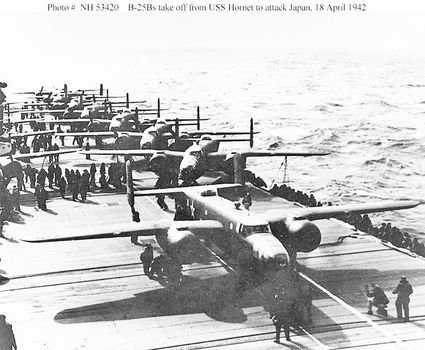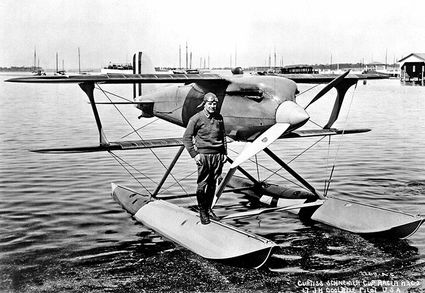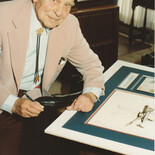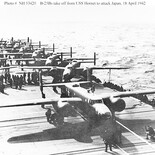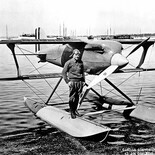General Jimmy Doolittle – 75th Anniversary of the Doolittle Raid
Short Flights
This year, 2017, marked the 75th anniversary of the Doolittle Raid and I make a point to remember the 80 brave men who flew the B-25s off of the USS Hornet on April 18, 1942. I have wonderful memories of meeting General Doolittle on several occasions. Once at the 8th Annual Barnstormers Reunion, with Pancho Barnes and Max Stanley, Northrop YB-49 test pilot as speaker, at the old Antelope Valley Fairgrounds in the late-1970s. Doolittle's wife, Josephine, was there too. She was delightful to talk with and was happy to share what it was like to live with a man who was so focused and talented.
Just happened to be in the right place at the right time and there he was on the flightline at William J. Fox Airfield. I must admit I was nearly speechless. To shake hands with aviation history, a Medal of Honor recipient and such a magnificent military hero to boot was overwhelming. I was delighted that both of my sons had the honor of meeting the General as well. They each have books where he signed the photo of him flying off of the carrier Hornet on that significant day in history.
Doolittle visited Bill Barnes often and I was working at Barnes Aviation at the time.
Doolittle was born in Alameda, Calif. on December 14, 1896, but spent much of his childhood in Nome, Alaska. His father, Frank, was a gold prospector and carpenter. Young Jimmy attended grade school, learned to fight bullies and pilot a dogsled during the early 1900s. In 1908, his family moved back to California.
He graduated from Manual Arts High School in Los Angeles, attended Los Angeles City College and won admission to the University of California, Berkeley where he studied in The School of Mines. He took a leave of absence from his education to enlist in the Signal Corps Reserve as a flying cadet. His ground training was at the School of Military Aeronautics (an Army school) on the campus of the University of California and flight training was accomplished at Rockwell Field. He received his Reserve Military Aviator rating and was commissioned a First Lieutenant in the Signal Officers Reserve Corps of the U.S. Army on March 11, 1918.
Doolittle was recommended for retention in the Air Service during demobilization at the end of WWI. He received a Regular Army commission as a 1st Lieutenant, Air Service, on July 1, 1920. He was one of the most famous pilots during this period and in September, 1922, he made the first of many pioneering flights. He flew a de Havilland DH-4, equipped with early navigational instruments, in the first cross-county flight from Florida to Rockwell Field in San Diego, Calif. The flight took 21 hours and 19-minutes, with only one fuel stop. The U.S. Army awarded him the Distinguished Flying Cross for this accomplishment.
Days later Doolittle was at the Air Service Engineering School at McCook Field, Dayton, Ohio. This assignment had special significance to him as he was not only a pilot, but had an extreme interest in aeronautical engineering. During the early 1920s pilots thought engineers just sat around and zipped slide rules back and forth and engineers thought pilots were crazy or otherwise they wouldn't be pilots.
He attended the Air Service Mechanical School at Kelly Field and the Aeronautical Engineering Course at McCook Field, Ohio and returned to complete his college degree. He earned a Bachelor of Arts from the University of California, Berkeley in 1922.
He was then sent to MIT (Massachusetts Institute of Technology) where in 1924, he earned his Masters of Science Degree in Aeronautical Engineering in one year and his Doctor of Science degree in 1925. Doolittle believed that there was a better understanding between pilots and engineers after some of the other pilots earned degrees in aeronautical engineering.
Air racing was the rage in the late 1920s and 1930s and Doolittle won every honor that was presented, including: the Schneider and Mackay Trophies in 1925, the Harmon Trophy in 1930, the Bendix Trophy in 1931 and the Thompson Trophy in 1932. For the Schneider Trophy race, Doolittle flew a Curtiss R3C-2 seaplane. The R3C-2 that Doolittle piloted to victory is preserved at the National Air and Space Museum's Steven F. Udvar-Hazy Centre at Washington Dulles Airport and still has the racing number '3' clearly visible.
For the Tokyo raid, there were sixteen air crews trained for this special secret mission in April, 1942 and the land based B-25 Mitchell medium bomber was chosen personally by Doolittle. What a man and what a mission!
Jonna Doolittle Hoppes wrote the book "Calculated Risk: The Extraordinary Life of Jimmy Doolittle", about her famous grandfather and the daring raid on Japan.
Jonna said that her grandfather was blessed with an analytical mind and most of his "stunts" were the result of careful study and planning. He was the master of the calculated risk.
There were those who claim that the Tokyo Raid was a suicide mission. This is not true. Although it was dangerous, the planning and execution of the Raid were based on calculation and study. Every man on that mission had reason to believe that he had a good chance of returning home safely. The Tokyo Raid was a calculated risk.
General Doolittle lived until Sept. 27, 1993, he was 96 when he passed away.
See you on our next flight!


